#sema-tawy
Text

Horus tying papyrus and reed plants in the symbol of the unification of the Upper and Lower Egypt, the sema tawy, opposite the god Set.
127 notes
·
View notes
Text

Heru-Sema-Tawy : Uniter of Two Lands
Artwork by Obsydian
10 notes
·
View notes
Photo
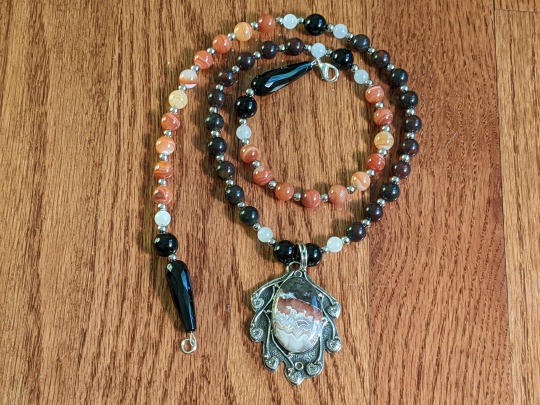



Heru-Sema-Tawy Devotional Necklace
(Horus, Uniter of the Two Lands)
Black Agate, Snow Quartz, Red Banded Agate, Brecciated Jasper, and Silver-Colored Metal Spacer Beads with a Silver and Laguna Lace Agate Pendant
https://www.etsy.com/.../egyptian-god-heru-sema-tawy-horus
#Kemetic#Pagan#Horus#Egyptian Mythology#Kemetic Orthodox#Egypt#Egyptian#Kemetic Pagan#Kemeticism#Heru#Heru-Sema-Tawy#Heru-Sa-Aset#Prayer Beads#Rosary#Devotional Jewelry#Kemetic Jewelry#Pagan Jewelry#Kemetic Necklace#Devotional Necklace#Kemetic Fandom
4 notes
·
View notes
Text
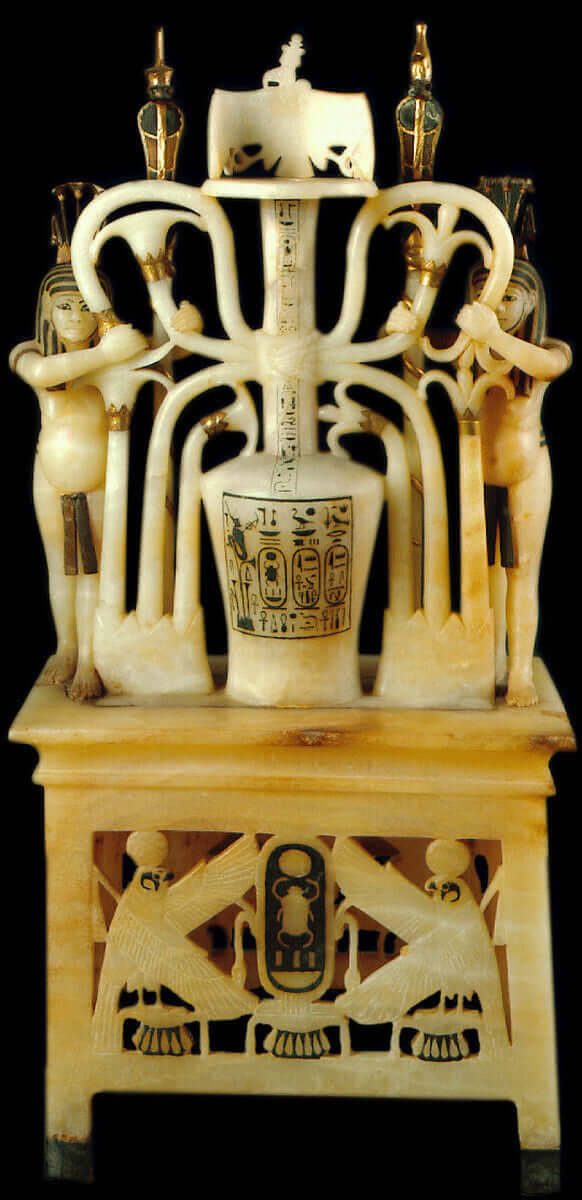
Alabaster Perfume Vase of Tutankhamun
Tutankhamun (KV62), Valley of the Kings
Egyptian Museum, Cairo. JE 62114
This perfume vase of King Tutankhamun is made of four pieces of alabaster cemented together. The idea conveyed by its symbolism is that the Nile will provide the king and queen, whose names are inscribed on the vase, with its contents. The vulture with the so-called Atef crown on its head represents either goddess Mut or Nekhbet protecting the perfume.
Flanking the vase are two deities with pendulous breasts and potbellies, both named Hapi, who personify the Nile and its fertility. They are differentiated by the lily and papyrus clusters on their heads as Hapi of Upper Egypt and Hapi of Lower Egypt, representing the sema-tawy symbol, unification of the kingdom.
Read more
503 notes
·
View notes
Text
Beginning of the End
Today is A'areq Ronpet (the last day of the Kemetic year).
Tomorrow begins the Days upon the Year, or those days which are "in between" this year and the next. On each of these days is birthed a God, in order: Wesir (or Osiris), Heru-wer (or Horus the Elder), Set, Aset (or Isis), and Nebt-het (or Nephthys).

Shrine is set up for the New Year in my personal tradition: The God of the current Year (on the left: Heru-Sema-Tawy in this case, or the statue I chose to represent Him) holds all of the beads for the individual Gods for the Days upon the Year as mentioned above.
Each day, an individual beadset (all are created by me) is returned to the God of the day, one by one, and the candle is lit. Prayers and offerings are made throughout the day.
When Wep Ronpet (the New Year) arrives on Saturday, the beads are transferred to the new God of the Year. Sometimes I'm unable to do this right away, as depending on who the God is, I may not have an appropriate statue, so in that case they will be put in a safe waiting place.
(And of course everyone is attended by my Jackal hoard)
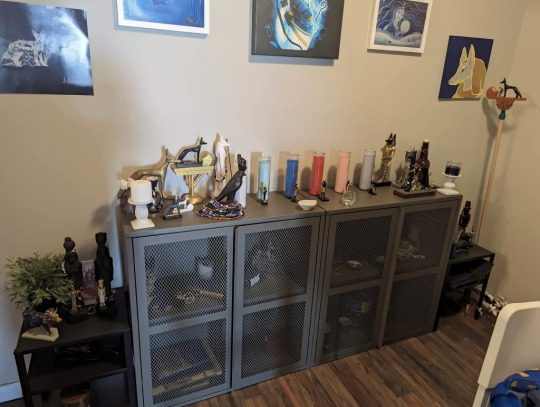
Now, I know what you're thinking:
I've made so many grievance posts about the House, KO, and Hemet, why would I trust the Oracle of the Year now that comes specifically from all of these things?
But what people keep missing about my posts is that I've never criticized her accuracy in terms of spirituality: I've been criticizing mostly the administrative side, how things are run, the way things like the rules and the board work, the lack of interaction between Hemet and the community, and the fact that her position in the organization has been inflated to say the list (the idea of "King").
That does not take away Hemet's talent and skill for what she does in a spiritual sense. I don't need to consider her King to consider her deeply spiritually accurate in many things. She is talented in divination, and it is one reason I accept my Parentage whole heartedly (in addition to the fact that I can know it is correct from my own interactions) -- though I'm not going to say she cannot err in terms of divination, as we all can -- and I will accept an Oracle coming from her for the year to come.
I've never been out to say Hemet is a bad person and that no one should follow her. Just the opposite: I would encourage people to listen to Hemet, because she has extremely important things to say.
I just really wish we had all heard more of those things on a regular basis.
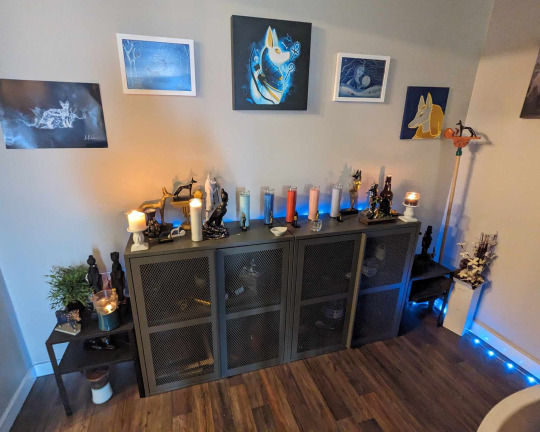
#kemet#kemetic orthodoxy#personal#blog#update#kemetic#kemeticism#religion#spirituality#organized religion#spiritual journey#wep ronpet#new year#shrine#altar#heru-wer#wesir#set#nebt-het#aset#isis#nepthys#osiris#horus#sutekh#seth#gods
27 notes
·
View notes
Photo
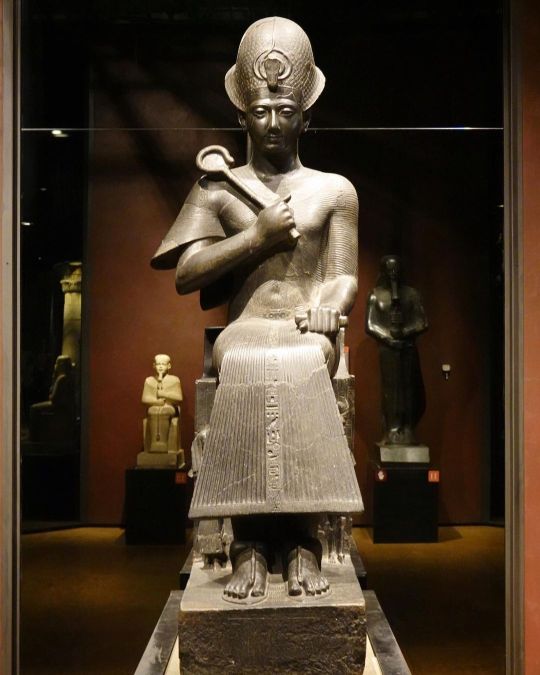
Granodiorite Statue of Ramesses II The king 𓇓𓏏𓈖 “nsw” is depicted in all his majesty. He wears the khepresh crown 𓆣𓂋𓈙𓋙 “ḫprš” and holds the heka sceptre 𓋾𓏘𓄿 “ḥq3” against his chest. His transparent pleated ceremonial dress reveals his muscled body 𓄡𓏏𓏤 “ẖ.t”. Under his sandals 𓍿𓃀𓏏𓋸𓋸 “tjbw.ty” he tramples the Nine Bows 𓌔𓏏𓐂 “psḏ.t”, symbols of the enemies 𓐍𓆑𓏏𓏭𓀏 “ḫfty” of Egypt. On the sides of the throne 𓊨𓏏𓉗 “3s.t” is carved the sema-tawy 𓋍, the knotted heraldic plants of Upper and Lower Egypt representing the union of the Two Lands 𓇾𓇾 “t3wy”. Dynastic continuity is expressed by the figures of his wife Nefertari (𓏏𓅐𓄤𓇋𓏏𓂋𓏭𓈘𓏏) “nfr-tı͗-rı͗-mrı͗.t-mwt” ‘Beautiful Companion, Beloved of Mut’ and his son Amunherkhepeshef on either side of his legs. The long reign of Ramesses lI (𓇳𓏤𓄟𓋴𓇓) “rˁ-msi-sw” ‘Him, Born of Ra’ probably witnessed a stylistic evolution of the royal portrait. The statue 𓂙𓏏𓏭𓀾 “ḫnty” probably belongs to the beginning of the reign of Ramesses I. In any case, it can be no later than the first half of the reign, due to the presence of Queen Nefertari, who died in year 30, This statue is one of the symbols of the @museoegizio In a letter that he wrote during his stay in Turin in 1824, Champollion describes with enthusiasm "the beauty and the admirable perfection of this colossal figure (….): for six whole months I have seen it every day, and always I have the impression of seeing it for the first time. The head is divine, the feet and hands are admirable, the body is voluptuous; I call it the Egyptian Apollo of the Belvedere... in short, I am in love with it”. Granodiorite. New Kingdom, 19th Dynasty, reign of Ramesses II (1279-1213 BC) Karnak, temple of Amon Drovetti Collection (1824). 📸 Richard Mortel - Flickr (Thank you) 𓋹𓎬𓋹𓎬𓋹𓎬𓋹𓎬𓋹𓎬𓋹𓎬𓋹𓎬𓋹𓎬𓋹𓎬𓋹𓎬𓋹𓎬𓋹𓎬𓋹𓎬𓋹𓎬 @egyptologylessons 𓋹𓊽𓋴𓆖𓎛𓇳𓎛 © 𓊁𓊁𓊁𓊁𓊁𓊁𓊁𓊁𓊁𓊁𓊁𓊁𓊁𓊁𓊁 #Ancientegypt #ägypten #egyptology #egypte #egitto #埃及 #مصر #egipto #이집트 #ramsesiii #egyptianstatue #granodiorite #pharaoh #turinmuseum https://www.instagram.com/p/CpilESKuK63/?igshid=NGJjMDIxMWI=
#ancientegypt#ägypten#egyptology#egypte#egitto#埃及#مصر#egipto#이집트#ramsesiii#egyptianstatue#granodiorite#pharaoh#turinmuseum
35 notes
·
View notes
Text
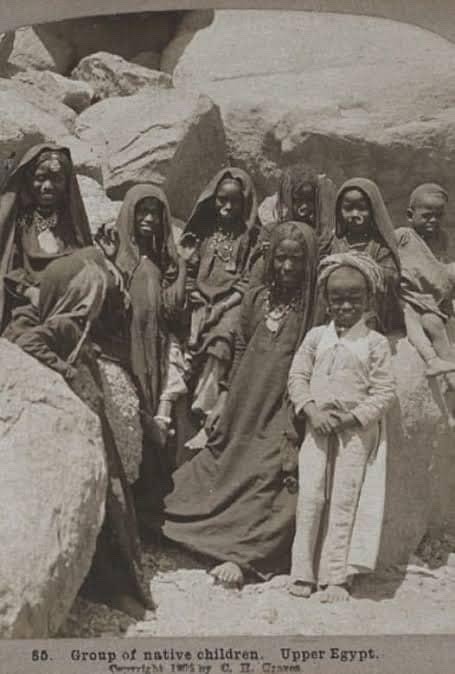


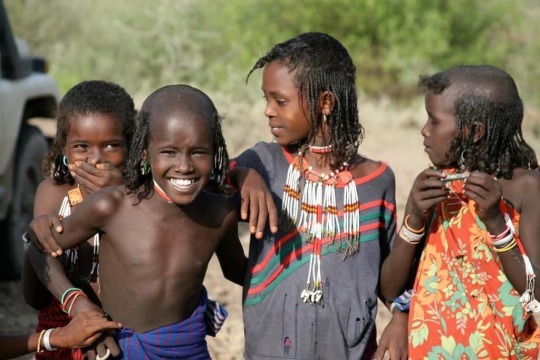






The indigenous peoples of the Hapi Valley were not Egytians or Nubians but rather Kemetyu and Nehesu, written in the Medu Neter as, 𓆎𓅓𓏏𓊖 and 𓅘𓎛𓋴 𓅫𓀎. They were sister civilizations with common culture and lineage in north east Africa. These ancient neolithic populations first migrated from the source of the Hapi which is in what European scholars love to call “Sub Sahran” Africa. It should be noted that this is a modern concept which these ancient populations did not adhere to.
The Source of the Blue Hapi being Lake Tana in Ethiopia and the White Hapi being Lake Victoria in Tanzania. Ta-Seti, Ta-Netjer and Ta-Meri evolved side by side, intermarried, traded, had alliances and conflicts. The Nation is Kemet, not Egypt and the region is Ta-Meri. In Medu Neter "Ta" means Land and Meri means Beloved (Beloved Land), and it was located in modern day Egypt and North Sudan. Ta-Netjer which is modern day Somalia and Northern Kenya translates to "Land of the Gods", Know as Punt of Puntland, indigenous known as Pwenet. Ta-Seti which is modern day Sudan translates to Land of the Bow, due to their world renowned Archers. They were masters of a style of archery known as "the double shot", which allowed them to fire two arrows almost simultaneously.
Narmer the first Pharaoh of Kemet was from Nehken which is modern day Aswan. He defeated the people of the Delta and Unified Upper and Lower Kemet. The people of Aswan today maintain their African identity as well as their dark Melanin.
Ta-Seti predates the unification of Ta-Meri known as Sema Tawy. Proof of this is the Qustul Burner which depicts Pharaonic iconography, a clear and concise artifact that proves Nwsts ruled in Ta-Seti in the Qustual and Naqada Regions around the same time if not before Menes came from the South and conquered the peoples who dwelled in the wet marshlands of the Delta. Menes came from the Nekhen, modern day Aswan, but his ancestors came from further south, down the Hapi river. He wore the white crown of Upper Kemet before the nation of Kemet was established, the same white crown depicted on the Qustul Incense Burner. These 3 civilizations, Ta-Meri, Ta-Seti, and Ta-Netjer comprised the Hapi Valley civilization.
The most clear-cut evidence of the origins of predynastic Kemetic culture is the 5,600 year old Black Mummy of the Green Sahara and the 9,000 year old Nabta Playa Stone Circle. This Black mummies remains was identified to belong to the A-Group, same as the cemeteries found in Qustual and Naqada. Also found was the earliest signs of cattle iconography and the worship or Het-Heru known later as Hathor, the Lady of Punt, or Pwenet. The Nabta Playa Stone Circle is one of the oldest astrological sites in the world. Adams Calendar which is located in South Africa being the oldest. At these sites they studied the procession of the equinox for thousands of years which allowed them to predict the monsoon seasons to grow their crops. Nabta Playa is also the site where humans first developed geometry and the concept of Pi. Around 3,400 BC drastic weather changes turned these luch tropical regions to desert and this is when these ancient Africans packed up and migrated northward following the flow of the Hapi river all the way to the Delta. These are the origins of Kemetic culture and science and the rest is history.
9 notes
·
View notes
Text
Read Aset oracle here -> http://www.nisut.org/2022/07/aset-oracle-year-30.html?m=1
Deity of the Year: Heru-sa-Aset as Sema-Tawy , “Uniter of the Two Lands”
Colors of the Year: red and black (for the Two Lands of Kemet)
16 notes
·
View notes
Note
Could you please use the Sekhmet tarot deck to ask Heru and/or Set if they have any instructions for our current operation? Tysm!-smarmy
Hello @smarmykemetic! Thank you for your patience, I apologize for taking so long to get to your reading! I did have some variation to your reading that I wasn't expecting- please let me know if you have any questions regarding it!
Your reading is interesting in the fact that when I went to draw cards for the Netjeru, I got Heru-sa-aset in addition to Heru-wer along with Set. When I went to draw Context cards, I also got three cards as well (The Nine of Swords for Set, and the Three of Wands and King of Cups for Heru). I get a feeling that Heru is not solely Heru-wer in this instance, nor is He solely Heru-sa-aset. I get a feeling this could be a specific epithet of Heru coming forward, in the form of Her-sema-tawy (Heru, Uniter of the Two Lands).
I see Them both in an oasis of sorts, back to back. Set appears with a falcon head, looking quite similar to Heru. I get the idea that They are two sides of the same coin, both together yet polar opposites. In these iterations, they bring balance to chaos (and perhaps bring chaos to unbalanced situations rife with ifset). Both are Gods of Growth and Life, while also having Their hands in Destruction. Both of them speak in tandem.
"Let go of your anxiety and fears. Uncertainty is always a constant, but being able to wield that in your favor makes you stronger. Keep balance in your emotions. Do not act without consideration, and do not lose control of yourself. You will be much stronger for it."

Interested in a free reading? Check out my free services post!
2 notes
·
View notes
Photo

https://youtube.com/shorts/WH40pmxsdDM Harsomtus is the Greek form of the Egyptian name Her Sema Tawy #mythology Heru #greek #Kemet @MelaninGoddessU
0 notes
Text
TR1: Sanctuary of the Scion (1)
It's time to pick up where I got. It's time to finish this level and the game.
12.01 - the sema symbol. As the level progresses Lara sees the second piece of the scion on a block. The block has a symbol in it called Sm3 (Sema) which is to unite the two lands: lower and upper-Egypt. The reed and lotus.
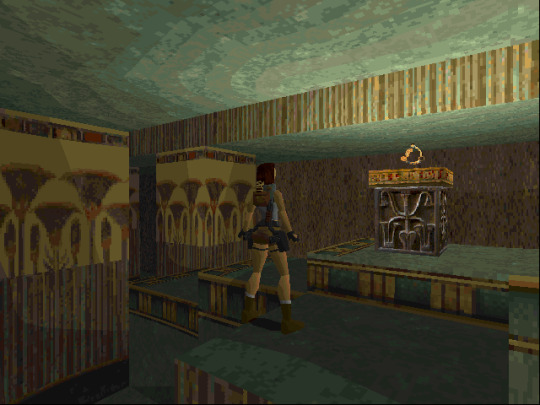
The conquest of Lower Egypt
To the legend of ancient Egypt, the countries were united by Menes the first king of Egypt in the first dynasty. He conquered from Upper the lower Egypt. In historical perspective there were kings in Upper-Egypt buried in Umm el-Qaab that are local kings like king Scorpion I, Bull, Elephant, Hat-Hor, Iry-Hor and others. King Scorpion II from dynasty 0 (before the first dynasty, not to confused with dynasty 00) was the first one that conquered Lower Egypt, then his son (?) King Narmer finished the war between the both Egypts. The symbolism is that every king should remain heavenly order (ma-at) in Egypt and that is to unite or to reunite Egypt and have 1 king on the throne just like king Menes did.
The sema symbol is depicted with Horus and Seth or Buto (snake goddess of the double city of Pe and Deb) or and Nechbet (vulture goddess of the city of nekhen). The symbol can be seen on thrones or on statues.
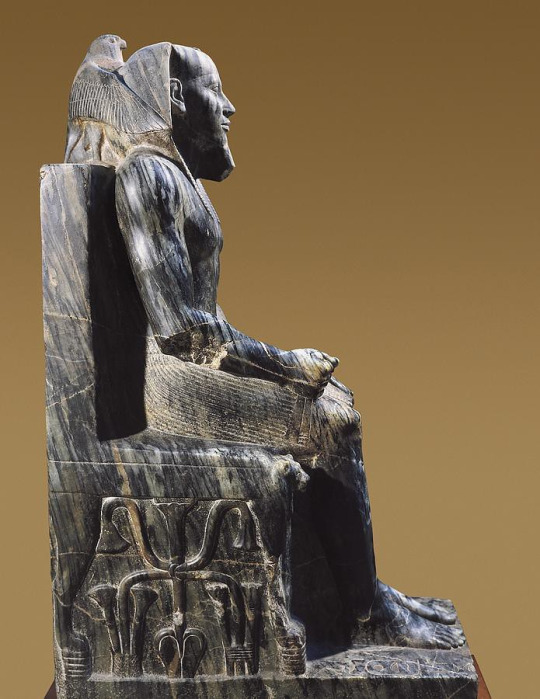
The symbol can be compared with this statue of king Khafre or Chephren according to the Greeks. A king of the 4th dynasty, his pyramid is in Gizeh near Caïro (or Gizeh in Caïro today). This statue has an unique design, the god horus protect the head of the ruler, he is wearing a Nemes-headdress.
Next one will be Natla's mines.
21 notes
·
View notes
Photo


Sema-Tawi Smart as Chanteuse in SOLO: A STAR WARS STORY – 2018
Source: imdb.com
14 notes
·
View notes
Text

Horus and Set performing the Sema-Tawy ritual (lotus and papyrus entwined; the unification of Upper and Lower Egypt)
Traditionally this is a ceremony performed by Hapi, God of the Nile
#horus#set#ancient egypt#ancient history#history#egyptian mythology#egyptian hieroglyphs#egyptian gods#egyptian afterlife#egyptian art#egyptology
197 notes
·
View notes
Photo



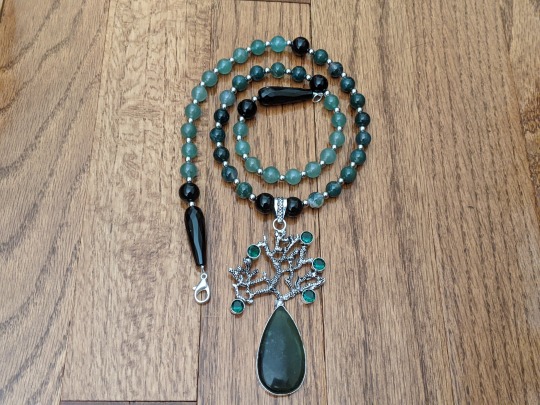



KEMETIC DEVOTIONAL NECKLACES
https://www.etsy.com/shop/tjemsypresents
Help support a multiply-neurodivergent creator with chronic pain during COVID-related loss of work! All necklaces pictured above are still available, with many more to choose from in my shop, featuring deities like
- Bast (Bastet)
- Heru-Wer (Horus the Elder)
- Hethert (Hathor, Hetheru)
- Nefertem
- Nit (Neith)
- Sekhmet (Sachmis)
- Set (Seth, Sutekh, Setesh)
**Commissions also available**
first row:
EGYPTIAN GODDESS NUT (NUIT) DEVOTIONAL NECKLACE
black agate, gold hematite, and lapis lazuli with silver-colored metal spacer beads, and a silver & sapphire (lab-created) heart/butterfly pendant
second row, left to right:
EGYPTIAN GODDESS TEFNUT DEVOTIONAL NECKLACE
black agate, rainbow fluorite, opalite, and angelite, with silver-colored metal spacer beads, and a silver, owyhee opal, & blue topaz eye-shaped pendant
EGYPTIAN GODDESS SERQET (SELKET, SERKET, SELKIS) DEVOTIONAL NECKLACE
black agate, gold hematite, and red jasper with a silver & red snakeskin jasper “scorpion” pendant
EGYPTIAN GOD WESIR (OSIRIS, AUSAR) DEVOTIONAL NECKLACE
black agate, green aventurine, and green moss agate, with silver-colored metal spacer beads, and a silver, green tourmaline, & jade tree-shaped pendant
third row:
EGYPTIAN GODDESS NEBTHET (NEPHTHYS) & EGYPTIAN GOD YINEPU (ANUBIS, ANPU) DEVOTIONAL NECKLACE
black agate, rose quartz, amethyst, howlite, and snowflake obsidian, with a silver & onyx pendant
EGYPTIAN GODS YINEPU (ANUBIS, ANPU) & WEPWAWET (UPUAT) DEVOTIONAL NECKLACE
black agate, snowflake obsidian, and blue spot jasper with silver-colored metal spacer beads, and a silver & silver sheen obsidian pendant
bottom row:
EGYPTIAN GOD HERU-SEMA-TAWY (HORUS THE UNITER) DEVOTIONAL NECKLACE
black agate, red banded agate, brecciated jasper, and snow quartz with silver-colored metal spacer beads, and a silver & laguna lace agate pendant
Thank you for your support! <3
#Kemetic#Pagan#Devotional Jewelry#Egyptian Gods#Goddess#Pagan Jewelry#Kemetic Jewelry#Prayer Beads#Rosary#Nut*#Tefnut#Serqet#Wesir#Osiris#Yinepu#Anubis#Nebthet#Nephthys#Wepwawet#Upuat#Heru-Sema-Tawy#Kemetic Orthodox#Egyptian Mythology#Kemetic Fandom
27 notes
·
View notes
Photo

This perfectly modeled and well-polished life-size statue depicts king Khafra, the builder of the second largest pyramid at Giza. It was found in a pit in the antechamber of his Valley Temple at Giza. The king is seated on a throne flanked by lion heads. The two sides of the throne are decorated with the sema-tawy, symbol of the unity of Upper and Lower Egypt. #iregipto #egyptpassion #discoveregypt #thisisegypt #egypt #MBPlanet #egypt #cairo #EgyptianMuseum (at Egyptian Museum & Royal Mummies Hall) https://www.instagram.com/p/CLYdxvhn8ol/?igshid=o4y1kx0ymh0u
15 notes
·
View notes
Photo

Colossal Statue of Amenhotep III, reworked, reinscribed by Merneptah (2nd Statue) This colossus of Amenhotep III (𓇋𓏠𓈖𓏏𓊪𓊵) “ı͗mn-ḥtp” ‘Amun is Content’, whose distinctive facial features are still recognizable despite their damaged state, once adorned the temple 𓉞𓏏𓉐 “ḥw.t” he built 𓇋𓐪𓂧𓋪𓅱𓀨 “ı͗qdw” to Amen-Re 𓇋𓏠𓈖𓇳𓏤 “ı͗mn-rˁ” in Luxor 𓇋𓊪𓏏𓊒𓇔𓏏 “ip.t-rsw.t” ‘Southern Sanctuary’ (ancient Thebes 𓌀𓏏𓈈𓊖 “w3s.t”). Like so many Dynasty 18 monuments, this statue 𓂙𓏏𓏭𓀾 “ḫnty”, along with its partner (22.5.2), was usurped a century and a half later by Merneptah (𓁰𓁧𓈘𓈖𓊵𓁷𓏤) “mri-n-ptḥ ḥtp-ḥr-mAAt” ‘Beloved of Ptah, Maat is Satisfied’, who was the son of Ramses II and had it moved from its original location to the eastern 𓋁𓃀𓏏𓏭𓈊 “3bty” portal of the temple. Merneptah's deeply incised titulary contrasts with the restrained carving of the 𓋍 Sema Tawy ("Unification of the Two Lands") motif on both sides of the throne 𓊨𓏏𓉗 “3s.t” of this, the larger of the colossi. Period: New Kingdom Dynasty: Dynasty 18 Reign: reign of Amenhotep III Date: ca. 1390–1353 B.C. Geography: From Egypt, Upper Egypt, Thebes, Luxor (el-Uqsur), Temple of Amun, Eastern Portal Medium: Porphyritic diorite Dimensions: H. 245.1 cm (96 1/2 in) W. of base 71.1 cm (28 in); d. 123.2 cm (48 1/2 in) Weight 3674.1 kg (8100 lbs) 𓋹𓎬𓋹𓎬𓋹𓎬𓋹𓎬𓋹𓎬𓋹𓎬𓋹𓎬𓋹𓎬𓋹𓎬𓋹𓎬𓋹𓎬𓋹𓎬𓋹𓎬𓋹𓎬𓋹𓎬𓋹𓎬 📸 @egyptologylessons 𓋹𓊽𓋴𓆖𓎛𓇳𓎛 © (@metmuseum and description) 𓊁𓊁𓊁𓊁𓊁𓊁𓊁𓊁𓊁𓊁𓊁𓊁𓊁𓊁𓊁𓊁𓊁 (at The Metropolitan Museum of Art, New York) https://www.instagram.com/p/CgZe14EuO4B/?igshid=NGJjMDIxMWI=
22 notes
·
View notes